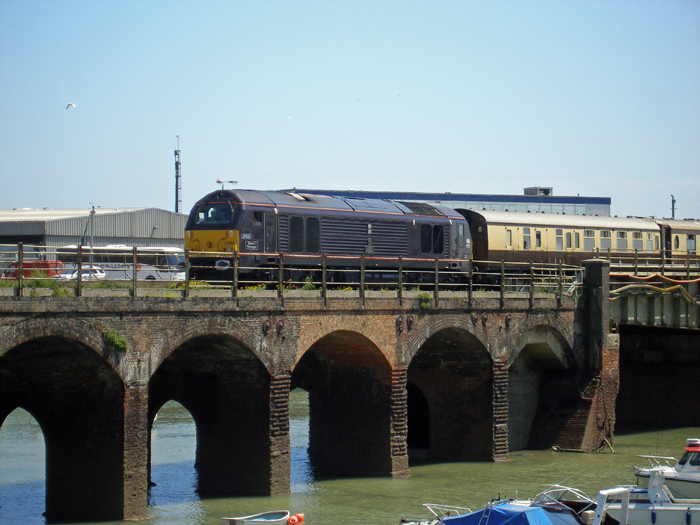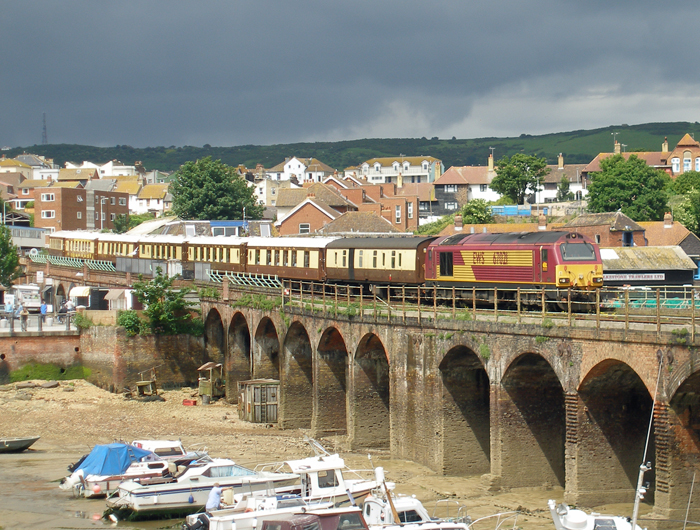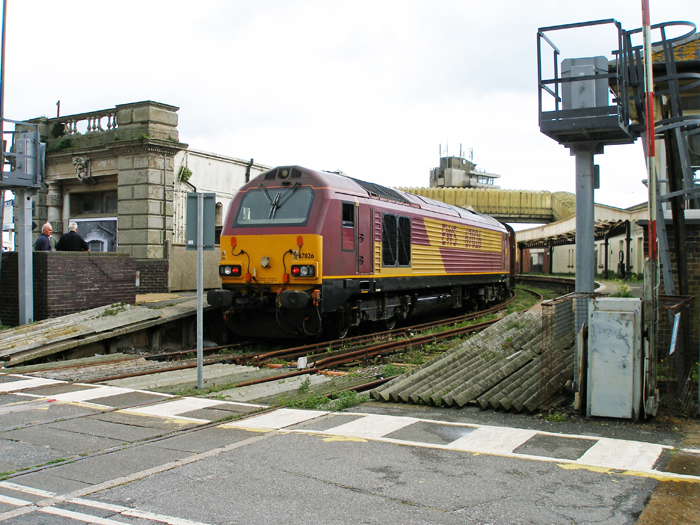
From Sunday 11th June 2006, Class 67s completely replaced Class 37s on the Edinburgh to Fort William section of the sleeper from Euston. This coincided with the start of the summer timetable and was in an effort to improve service reliability. However, due to the fleet's high axle-loading, severe speed restrictions were imposed when passing over the West Highland Line's viaducts and bridges.
On Monday 28th April 2008, a new service commenced between London Marylebone and Wrexham, via Shrewsbury and Wellington. This comprised five trains a day in either direction on weekdays, four on Saturdays, and three on Sundays, and the services were operated under a newly-formed open-access operator called the "Wrexham, Shropshire and Marylebone Railway" (WSMR). This was a joint venture between "Renaissance Trains Limited" and "Deutsche-Bahn" (the latter through a subsidiary called "Deutsche-Bahn Regio") and used a fleet of refurbished BR Mk 3 carriages and 82xxx series DVTs, formerly of the WCML. Five Class 67 diesels were dedicated to the service and subsequently painted into the WSMR dark grey and silver scheme, these being Nos. 67010, 67012, 67013, 67014, and 67015, and driver training on the route had commenced in February 2008.
Unfortunately, the WSMR service did not attract enough passengers to make it profitable and the operator ceased running on 28th January 2011. However, this was not the end of locomotive haulage from Marylebone and the stock was subsequently absorbed into the "Chiltern Railways" franchise. The latter has been owned by Deutsche-Bahn since 2008, when it bought out Chiltern Railways' parent company "Laing Rail". Twenty BR Mk 3 carriages were dispatched to Wabtec, Doncaster, for refurbishment, the main part of which involved replacing the existing slam-doors with automatic sliding-plug types. The carriages, once again sandwiched in-between a DVT and Class 67, were deployed on the Marylebone to Birmingham Moor Street route on 28th May 2012.
On 15th December 2008, Arriva Trains Wales launched an early morning weekday Cardiff to Holyhead service, via Crewe, a journey which took four hours 26 minutes. This used BR Mk 2 stock hauled by Class 57/3 diesels, the latter subleased from Virgin Trains which had used them as "Thunderbird" rescue locomotives. This train was complemented by a second Cardiff to Holyhead working, which left later in the morning and was nine minutes quicker, running via Wrexham rather than Crewe. Class 57/3 haulage lasted until 23rd March 2012, at which stage DB Class 67 locomotives took charge. Nos. 67001, 67002, and 67003 were dedicated to the service, for which all three were repainted in all-over plain blue.
In 2014, the Caledonian Sleeper was separated from ScotRail and became a standalone franchise as part of a new bidding process. On 28th May of that year, it was announced that "SERCO" had been awarded a fifteen year deal to operate the franchise, commencing on 1st April 2015, with £800,000,000 of revenue being forecast. On 17th February 2015, it was announced that Eurotunnel-owned Great Britain Railfreight (GBRf) had been awarded the contract to supply locomotives and crew for the new franchise, replacing incumbent DB. Motive power would be in the form of six rebuilt Electro-Diesels of a new subclass, 73/9, although the full number of locomotives were not scheduled to be available until October 2015. In the interim, until the 73/9 locomotives were ready, GBRf was to hire Class 47s from "Harry Needle Railroad Company" (HNRC) to haul the sleepers. However, in March 2015, GBRf struck a deal with DB to hire four Class 67s for the service, instead of using Class 47s.
On 23rd March 2015, the new Caledonian Sleeper branding was unveiled at Inverness station, which included the naming of Class 67 No. 67004 (formerly called "Post Haste") as "Cairn Gorm". The locomotive had been repainted into an all-over "Midnight Teal" livery with a centrally-aligned white "Highland Stag" logo, a scheme which was also applied to the carriages. The hiring of Class 67s for the Caledonian Sleeper ended on 30th June 2016, somewhat later than originally forecast, when there was a sufficient number of 73/9s available.
As mentioned earlier, one of the workings inherited from the RES sector of BR was that of hauling the Royal Train. In 2005, EWS dedicated two Class 67 locomotives to this duty, Nos. 67005 and 67006, the pair of which were repainted into "Royal Plum" livery. Of course, the Royal Train was not a regular working and these locomotives were also deployed on other duties, notably the VSOE Pullman.

Trailing on the rear of the "down" VSOE at Folkestone Harbour was "Royal Plum" liveried No. 67005 "Queen's Messenger", which became a regular fixture on this glamorous working when not on stately duties. © David Glasspool

The Folkestone Harbour branch had supposedly closed on 12th April 2008, but evidently this was just ceremonial, for the VSOE from Victoria continued to use the line that summer on Thursdays and Sundays. No. 67021 is seen descending the branch, an ex-Scottish Sleeper generator coach separating the locomotive from a splendid collection of Pullman cars. © David Glasspool

No. 67026 had led the VSOE from Victoria to Folkestone Junction, but a reversal at the latter put No. 67021 at the front for the trip down the branch line. The level crossing's barriers were no longer operational and the running rails which once served platform 1 had gone, just leaving a rusty conductor rail. © David Glasspool
Return to the Kent Rail Homepage or alternatively, check for Updates.
Website & Copyright information - Links - Contact the Webmaster